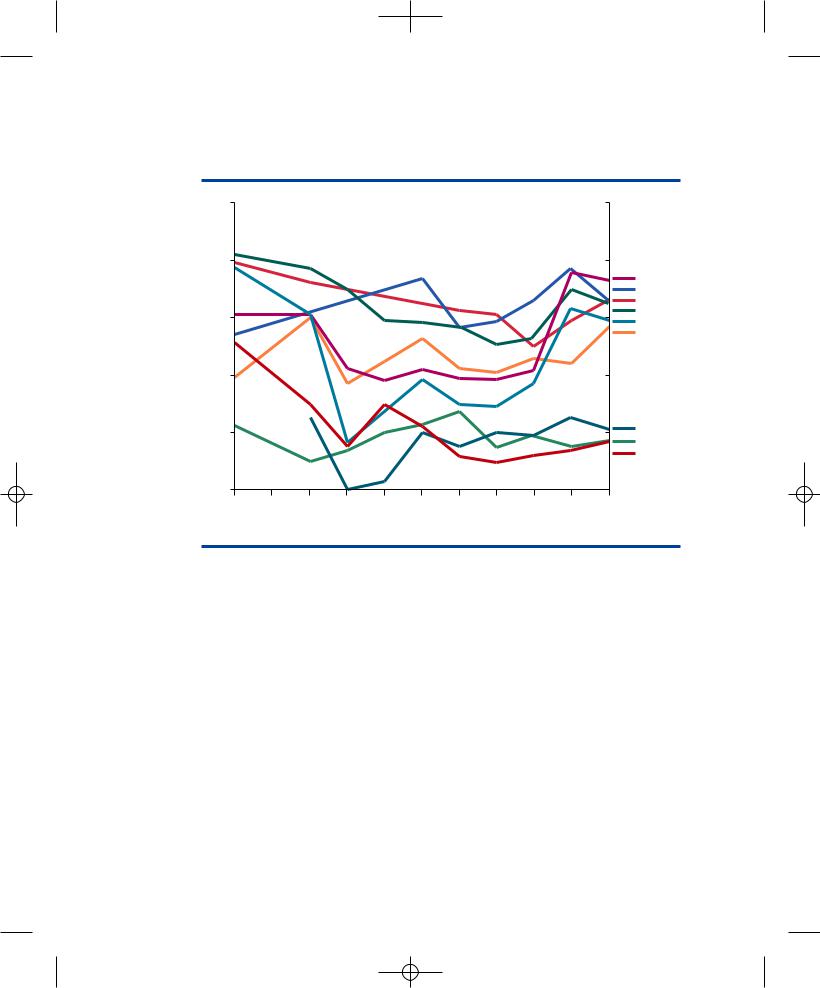
Realism
.pdf
M02_GOLD9584_06_SE_C02.QXD 1/13/11 7:26 PM Page 35 
Israeli Artillery firing on
Gaza, 2009.
CHAPTER 2 Realist Theories
Realism
No single theory reliably explains the wide range of international interactions, but one theoretical framework has historically held a central position in the study of IR. This approach, called realism, is favored by some IR scholars and vigorously contested by others, but almost all take it into account.
Realism (or political realism) is a school of thought that explains international relations in terms of power. The exercise of power by states toward each other is sometimes called realpolitik, or just power politics.
Modern realist theory developed in reaction to a liberal tradition that realists called idealism. Idealism emphasizes international law, morality, and international organization, rather than power alone, as key influences on international events. Idealists think that human nature is basically good. They see the international system as one based on a community of states that have the potential to work together to overcome mutual problems (see Chapter 3). For idealists, the principles of IR must flow from morality.
Idealists were particularly active between World War I and World War II, following the painful experience of World War I. U.S. president Woodrow Wilson led the effort to create the League of Nations, a forerunner of today’s United Nations. But the U.S. Senate did not approve, and the League proved ineffective. U.S. isolationism between the world wars, along with declining British power and a Russia crippled by its own revolution, left
CHAPTER OUTLINE
■Realism
■Power
■The International System
■Alliances
■Strategy
PODCAST
35

M02_GOLD9584_06_SE_C02.QXD 1/13/11 7:26 PM Page 36 
36Chapter 2 Realist Theories
a power vacuum in world politics that Germany and Japan filled in the 1930s. In an effort to appease German ambitions, Britain and France agreed in the Munich Agreement of 1938 to let Germany occupy part of Czechoslovakia. This “appeasement” seemed only to encourage Hitler’s further conquests. Yet the lessons of the two world wars seem contradictory. From the failure of the Munich Agreement in 1938 to appease Hitler, many people have concluded that only a hard-line foreign policy with preparedness for war will deter aggression and prevent war. Yet in 1914 it was just such hard-line policies that apparently led Europe into a disastrous war, which might have been avoided by appeasement. Evidently the best policy would be sometimes harsh and at other times conciliatory.
After World War II, realists blamed idealists for looking too much at how the world ought to be instead of how it really is. Sobered by the experiences of World War II, realists set out to understand the principles of power politics without succumbing to wishful thinking.
Realists ground themselves in a long tradition. The Chinese strategist Sun Tzu, who lived 2,000 years ago, advised the rulers of states how to survive in an era when war had become a systematic instrument of power for the first time. Sun Tzu argued that moral reasoning was not very useful to the state rulers of the day, faced with armed and dangerous neighbors. He showed rulers how to use power to advance their interests and protect their survival.
At roughly the same time, in Greece, Thucydides wrote an account of the Peloponnesian War (431–404 B.C.) focusing on relative power among the Greek citystates. He stated that “the strong do what they have the power to do and the weak accept what they have to accept.” Much later, in Renaissance Italy (around 1500), Niccolò Machiavelli urged princes to concentrate on expedient actions to stay in power, including the manipulation of the public and military alliances. Realists see in these historical figures evidence that the importance of power politics is timeless and cross-cultural.
After World War II, scholar Hans Morgenthau argued that international politics is governed by objective, universal laws based on national interests defined in terms of power (not psychological motives of decision makers). He reasoned that no nation had “God on its side” (a universal morality) and that all nations had to base their actions on prudence and practicality. He opposed the Vietnam War, arguing in 1965 that a communist Vietnam would not harm U.S. national interests.
Similarly, in 2002, before the U.S. invasion of Iraq, leading realists figured prominently among the 33 IR scholars signing a New York Times advertisement warning that
TABLE 2.1 |
Assumptions of Realism and Idealism |
|
|
||
|
Issue |
|
Realism |
Idealism |
|
|
|
|
|
|
|
|
Human Nature |
|
Selfish |
Altruistic |
|
|
Most Important Actors |
States |
States and others |
||
|
|
|
|
including individuals |
|
|
Causes of State Behavior |
Rational pursuit of self-interest |
Psychological motives |
||
|
|
|
|
of decision makers |
|
|
Nature of International System |
Anarchy |
Community |
||
|
|
|
|
|
|

M02_GOLD9584_06_SE_C02.QXD 1/13/11 7:26 PM Page 37 
Power |
37 |
FIGURE 2.1 |
Theories of IR |
Realism
Neorealism
Liberal Theories
(Kant)
Democratic |
Liberal Institutionalism |
Peace |
(Neoliberalism) |
|
|
|
L |
|
|
IA |
|
|
C |
|
|
O |
|
|
|
S |
|
|
|
|
|
ES |
|
RI |
|
EO |
|
|
TH |
|
|
Constructivist
Theories
Postmodernist
Theories
Marxism (Imperialism)
Peace Studies
Gender Theories
“war with Iraq is not in America’s national interest.” Thus realists do not always favor using military power, although they recognize the necessity of doing so at times. The target of the IR scholars’ ad was the group of foreign policy makers in the Bush administration known as neoconservatives, who advocated more energetic use of American power, especially military force, to accomplish ambitious and moralistic goals such as democratizing the Middle East.
Thus, realists assume that IR can be best (though not exclusively) explained by the choices of states operating as autonomous actors rationally pursuing their own interests in an international system of sovereign states without a central authority. Table 2.1 summarizes some major differences between the assumptions of realism and idealism.
For realists, ideologies do not matter much, nor do religions or other cultural factors with which states may justify their actions. Realists see states with very different religions, ideologies, or economic systems as quite similar in their actions with regard to national power. Thus, realism’s foundation is the principle of dominance; alternatives based on reciprocity and identity will be reviewed in Chapter 3. Figure 2.1 lays out the various theoretical approaches to the study of IR that we discuss in Chapters 2 and 3.
Power
Power is a central concept in international relations—the central one for realists—but it is surprisingly difficult to define or measure.

M02_GOLD9584_06_SE_C02.QXD 1/13/11 7:26 PM Page 38 
38 |
Chapter 2 Realist Theories |
Defining Power
Power is often defined as the ability to get another actor to do what it would not otherwise have done (or not to do what it would have done). A variation on this idea is that actors are powerful to the extent that they affect others more than others affect them. These definitions treat power as influence. If actors get their way a lot, they must be powerful. One problem with this definition is that we seldom know what a second actor would have done in the absence of the first actor’s power. There is a danger of circular logic: power explains influence, and influence measures power.
Power is not influence itself, however, but the ability or potential to influence others. Many IR scholars believe that such potential is based on specific (tangible and intangible) characteristics or possessions of states— such as their sizes, levels of income, and armed forces. This is power as capability. Capabilities are easier to measure than influence and less circular in logic.
Measuring capabilities to explain how one state influences another is not simple, however. It requires summing up various kinds of potentials. States possess varying amounts of population, territory, military forces, and so forth. The best single indicator of a state’s power may be its total GDP, which combines overall size, technological level, and wealth. But even GDP is at best a rough indicator, and economists do not even agree how to measure it. The method followed in this book adjusts for price differences among countries, but an alternative method gives GDP estimates that are, on average, about 50 percent higher for countries in the global North and about 50 percent lower for the global South including China (see footnote 2 on p. 12). So GDP is a useful estimator of material capabilities but not a precise one.
Power also depends on nonmaterial elements. Capabilities give a state the potential to influence others only to the extent that political leaders can mobilize and deploy

M02_GOLD9584_06_SE_C02.QXD 1/13/11 7:26 PM Page 39 
Power |
39 |
these capabilities effectively and strategically. This depends on national will, diplomatic skill, popular support for the government (its legitimacy), and so forth. Some scholars emphasize the power of ideas—the ability to maximize the influence of capabilities through a psychological process. This process includes the domestic mobilization of capabilities—often through religion, ideology, or (especially) nationalism. International influence is also gained by forming the rules of behavior to change how others see their own national interests. If a state’s own values become widely shared among other states, that state will easily influence others. This has been called soft power. For example, the United States has influenced many other states to accept the value of free markets and free trade.
As the concept of soft power illustrates, dominance is not the only way to exert power (influence others). The core principles of reciprocity and (in the case of soft power) identity can also work. For example, a father who wants his toddler to stop screaming in a supermarket might threaten or actually administer a spanking (dominance); he might promise a candy bar at the checkout as a reward for good behavior (reciprocity); or he could invoke such themes as “Be a big boy/girl” or “You want to help Daddy, don’t you?” (identity). Although realists emphasize dominance approaches, they do not dispute that states sometimes achieve their interests in other ways. Furthermore, even realists recognize that power provides only a general understanding of outcomes. Real-world outcomes depend on many other elements, including accidents or luck.
Because power is a relational concept, a state can have power only relative to other states’ power. Relative power is the ratio of the power that two states can bring to bear against each other. It matters little to realists whether a state’s capabilities are rising or declining in absolute terms, only whether they are falling behind or overtaking the capabilities of rival states.
Estimating Power
The logic of power suggests that in wars, the more powerful state will generally prevail. Thus, estimates of the relative power of the two antagonists should help explain the outcome of each war. These estimates could take into account the nations’ relative military capabilities and the popular support for each one’s government, among other factors. But most important is the total size of each nation’s economy—the total GDP. With a healthy enough economy, a state can buy a large army, popular support (by providing consumer goods), and even allies.
Elements of Power
State power is a mix of many ingredients. Elements that an actor can draw on over the long term include total GDP, population, territory, geography, and natural resources. These attributes change only slowly. Less tangible long-term power resources include political culture, patriotism, education of the population, and strength of the scientific and technological base. The credibility of its commitments (reputation for keeping its word) is also a long-term power base for a state. So is the ability of one state’s culture and values to consistently shape the thinking of other states (the power of ideas).

M02_GOLD9584_06_SE_C02.QXD 1/13/11 7:26 PM Page 40 
40 |
Chapter 2 Realist Theories |
Other capabilities allow actors to exercise influence in the short term. Military forces are such a capability—perhaps the most important kind. The size, composition, and preparedness of two states’ military forces matter more in a short-term military confrontation than their respective economies or natural resources. Another capability is the military-industrial capacity to quickly produce weapons. The quality of a state’s bureaucracy is another type of capability, allowing the state to gather information, regulate international trade, or participate in international conferences. Less tangibly, the support and legitimacy that an actor commands in the short term from
constituents and allies are capabilities that the actor can use to gain influence. So is the loyalty of a nation’s army and politicians to their leader.
Given the limited resources that any actor commands, trade-offs among possible capabilities always exist. Building up military forces diverts resources that might be put into foreign aid, for instance. Or buying a population’s loyalty with consumer goods reduces resources available to the military. To the extent that one element of power can be converted into another, it is fungible. Generally, money is the most fungible capability because it can buy other capabilities.
Realists tend to see military force as the most important element of national power in the short term, and other elements such as economic strength, diplomatic skill, or moral legitimacy as being important to the extent that they are fungible into military power. Yet, depending on the nature of the conflict in question, military power may be only one of many elements of power.
Morality can contribute to power, by increasing the will to use power and by attracting allies. States have long clothed their actions, however aggressive, in rhetoric about their peaceful and defensive intentions. Of course, if a state overuses moralistic rhetoric to cloak self-interest too often, it loses credibility even with its own population.
The use of geography as an element of power is called geopolitics. It is often tied to the logistical requirements of military forces. In geopolitics, as in real estate, the three most important considerations are location, location, location. States increase their power to the extent they can use geography to enhance their military capabilities, such as by securing allies and bases close to a rival power, or by controlling key natural resources. Today, control of oil pipeline routes, especially in Central Asia, is a major geopolitical issue. Military strategists have also pointed out that the melting of the continental ice shelf (see Chapter 8) has opened new shipping routes for military purposes, creating a new geopolitical issue for Russia and the United States.

M02_GOLD9584_06_SE_C02.QXD 1/13/11 7:26 PM Page 41 
The International System |
41 |
The International System
States interact within a set of long-established “rules of the game” governing what is considered a state and how states treat each other. Together these rules shape the international system.
The modern international system is sometimes dated from the Treaty of Westphalia in 1648, which ended the Thirty Years’ War. It set out the basic rules that have defined the international system ever since—the sovereignty and territorial integrity of states as equal and independent members of an international system. Since then, states defeated in war might have been stripped of some territories but were generally allowed to continue as independent states rather than being subsumed by the victor. Key to this system was the ability of one state, or a coalition, to balance the power of another state so that it could not gobble up smaller units and create a universal empire.
Anarchy and Sovereignty
Realists believe that the international system exists in a state of anarchy—a term that implies not chaos or absence of structure and rules, but rather the lack of a central government that can enforce rules. In domestic society within states, governments can enforce contracts, deter citizens from breaking rules, and carry out laws. Both democracies and dictatorships provide central government enforcement of a system of rules. Realists contend that no such central authority exists to enforce rules and ensure compliance with norms of conduct. This makes collective goods problems especially acute in IR. The power of one state is countered only by the power of other states. States must therefore rely on self-help, which they supplement with allies and the (sometimes) constraining power of international norms. In this anarchic world, realists emphasize prudence as a great virtue in foreign policy. Thus states should pay attention not to the intentions of other states but rather to their capabilities.
Despite its anarchy, the international system is far from chaotic. The great majority of state interactions closely adhere to norms of behavior—shared expectations about what behavior is considered proper. Norms change over time, slowly, but the most basic norms of the international system have changed little in recent centuries.
Sovereignty—traditionally the most important norm—means that a government has the right, in principle, to do whatever it wants in its own territory. States are separate and autonomous and answer to no higher authority. In principle, all states are equal in status, if not in power. Sovereignty also means that states are not supposed to interfere in the internal affairs of other states. Although states do try to influence each other (exert power) on matters of trade, alliances, war, and so on, they are not supposed to meddle in the internal politics and decision processes of other states. More controversially, some states claim that sovereignty gives them the right to treat their own people in any fashion, including behavior that other states call genocide.
The lack of a “world police” to punish states if they break an agreement makes enforcement of international agreements difficult. For example, in the 1990s, North Korea announced it would no longer allow inspections of its nuclear facilities by other states, which put it in violation of the Non-Proliferation Treaty (NPT). The international

M02_GOLD9584_06_SE_C02.QXD 1/13/11 7:26 PM Page 42 
42 |
Chapter 2 Realist Theories |
community used a mix of positive incentives and threats to persuade North Korea to stop producing nuclear material. But in 2002 North Korea withdrew from the NPT and built perhaps a half-dozen nuclear bombs, one of which it exploded in 2006 (the world’s first nuclear test in a decade). After reaching an agreement with the United States to stop producing nuclear weapons in 2008, North Korea refused to allow physical inspection of some of its nuclear facilities, arguing “it is an act of infringing upon sovereignty.” These examples show the difficulty of enforcing international norms in the sovereignty-based international system.
In practice, most states have a hard time warding off interference in their affairs. Such “internal” matters as human rights or self-determination are, increasingly, concerns for the international community. Also, the integration of global economic markets and telecommunications makes it easier than ever for ideas to penetrate state borders.
States are based on territory. Respect for the territorial integrity of all states, within recognized borders, is an important principle of IR. Many of today’s borders are the result of past wars or were imposed arbitrarily by colonizers.
The territorial nature of the interstate system developed long ago when agrarian societies relied on agriculture to generate wealth. In today’s world, in which trade and technology rather than land create wealth, the territorial state may be less important. Information-based economies are linked across borders instantly, and the idea that the state has a hard shell seems archaic. The accelerating revolution in information technologies may dramatically affect the territorial state system in the coming years.
States have developed norms of diplomacy to facilitate their interactions. Yet the norms of diplomacy can be violated. In 1979, Iranian students took over the U.S. embassy in Tehran, holding many of its diplomats hostage for 444 days—an episode that has soured American-Iranian relations ever since.

M02_GOLD9584_06_SE_C02.QXD 1/13/11 7:26 PM Page 43 
The International System |
43 |
Realists acknowledge that the rules of IR often create a security dilemma—a situation in which actions taken by states to ensure their own security (such as deploying more military forces) threaten the security of other states. The responses of those other states (such as deploying more of their own military forces) in turn threaten the first state. The dilemma is a negative consequence of anarchy in the international system. If a world government could reliably detect and punish aggressors who arm themselves, states would not need to guard against this possibility. Yet the self-help system requires that states prepare for the worst. Realists tend to see the dilemma as unsolvable, whereas liberals think it can be solved through the development of norms and institutions (see Chapters 3 and 6).
Balance of Power
In the anarchy of the international system, the most reliable brake on the power of one state is the power of other states. The term balance of power refers to the general concept of one or more states’ power being used to balance that of another state or group of states. Balance of power can refer to any ratio of power capabilities between states or alliances, or it can mean only a relatively equal ratio. Alternatively, balance of power can refer to the process by which counterbalancing coalitions have repeatedly formed in history to prevent one state from conquering an entire region. The theory of balance of power argues that such counterbalancing occurs regularly and maintains the stability of the international system. The system is stable in that its rules and principles stay the same: state sovereignty does not collapse into a universal empire. This stability does not, however, imply peace; it is rather a stability maintained by means of recurring wars that adjust power relations.
Alliances (to be discussed shortly) play a key role in the balance of power. Building up one’s own capabilities against a rival is a form of power balancing, but forming an alliance against a threatening state is often quicker, cheaper, and more effective. Sometimes a particular state deliberately becomes a balancer (in its region or the world), shifting its support to oppose whatever state or alliance is strongest at the moment. Britain played this role on the European continent for centuries, and China played it in the Cold War.
In the post–Cold War era of U.S. dominance, balance-of-power theory would predict closer relations among Russia, China, and even Europe to balance U.S. power. These predictions appear to be on the mark. Russian-Chinese relations have improved dramatically in such areas as arms trade and demilitarization of the border. French leaders have criticized U.S. “hyperpower.” Europe and Japan opposed U.S. positions on a range of proposed treaties in 2001 on such subjects as missile defense, biological weapons, small-arms trade, and global warming. In 2003, world public opinion revealed widespread anti-American sentiment. In Indonesia, Pakistan, Turkey, and Nigeria— containing half of the world’s Muslims—more than 70 percent worried that the United States could become a threat to their own countries, a worry shared by 71 percent of Russians. A survey of 38,000 people in 44 nations showed a dramatic drop in support for the United States from 2002 to 2003. As Figure 2.2 illustrates, this decline in favorable views of the United States worldwide continued through 2007. Yet, 2008 brought a slight upturn in opinions of the United States. A survey of 24,000 people in 24 countries found a more positive view of America in ten of those countries, mostly due to optimism about the Obama administration. Still, the predominance of U.S. power has led to counterbalancing, as predicted by balance-of-power theory.

M02_GOLD9584_06_SE_C02.QXD 1/13/11 7:26 PM Page 44 
44 |
Chapter 2 Realist Theories |
FIGURE 2.2 Views of the United States in Nine Countries, 2000–2010 (Percent favorable view in public opinion polls)
100% |
|
|
|
|
|
|
|
|
|
|
80 |
|
|
|
|
|
|
|
|
|
|
|
|
|
|
|
|
|
|
|
|
France |
|
|
|
|
|
|
|
|
|
|
India |
|
|
|
|
|
|
|
|
|
|
Japan |
60 |
|
|
|
|
|
|
|
|
|
Britain |
|
|
|
|
|
|
|
|
|
Indonesia |
|
|
|
|
|
|
|
|
|
|
|
Russia |
40 |
|
|
|
|
|
|
|
|
|
|
20 |
|
|
|
|
|
|
|
|
|
Jordan |
|
|
|
|
|
|
|
|
|
Pakistan |
|
|
|
|
|
|
|
|
|
|
|
|
|
|
|
|
|
|
|
|
|
|
Turkey |
0 |
|
|
|
|
|
|
|
|
|
|
2000 |
2001 |
2002 |
2003 |
2004 |
2005 |
2006 |
2007 |
2008 |
2009 |
2010 |
Source: New York Times from data of Pew Global Attitudes Project. 2000 data from State Department surveys.
Great Powers and Middle Powers
The most powerful states in the world exert most of the influence on international events and therefore get the most attention from IR scholars. By almost any measure of power, a handful of states possess the majority of the world’s power resources.
Although there is no firm dividing line, great powers are generally considered the half-dozen or so most powerful states. A system of great power relations has existed since around A.D. 1500, and the structure and rules of that system have remained fairly stable through time, although the particular members change. The structure is a balance of power among the six or so most powerful states, which form and break alliances, fight wars, and make peace, letting no single state conquer the others. Until the past century, the great power club was exclusively European. Sometimes great powers’ status is formally recognized in an international structure such as the 19th-century Concert of Europe or today’s UN Security Council. In general, great powers are often defined as states that can be defeated militarily only by another great power. Great powers also tend to share a global outlook based on national interests far from their home territories.
The great powers generally have the world’s strongest military forces and the strongest economies to pay for them. These large economies in turn rest on some combination of large populations, plentiful natural resources, advanced technology, and
